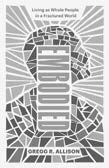Embodied: Living As Whole People In A Fractured World -- By: Jeremy M. Kimble
Journal: Eikon
Volume: EIKON 04:2 (Fall 2022)
Article: Embodied: Living As Whole People In A Fractured World
Author: Jeremy M. Kimble
Eikon 4.2 (Fall 2022) p. 148
Embodied: Living As Whole People In A Fractured World
REVIEWED BY
Jeremy M. Kimble is Associate Professor of Theology at Cedarville University. He is a member of Grace Baptist Church in Cedarville, OH, and is the author of several books including 40 Questions About Church Membership and Discipline.

Gregg R.Allison. Embodied: Living as Whole People in a Fractured World. Grand Rapids, MI: Baker, 2021.
The human body can be a neglected aspect of our Christian theology, but it is at the center of current cultural attention. We acknowledge that our bodies are part of the way God made us, but at times we can hold to a gnostic view that dispenses with thinking much of the body since we will simply slough it off someday. However, this kind of attitude among Christians can overlook the attention the world is giving to the body and, more importantly, misunderstands biblical teaching on how we are to think of ourselves as embodied beings. Increasingly, questions are posed regarding sexuality, physical presence in a particular space, and transhumanism, each of which touch on aspects of our being embodied beings.
Gregg Allison, professor of Christian Theology at Southern Seminary, delves into a variety of topics related to the human body in an effort to help readers understand and apply sound biblical-theological truth. Again, this kind of effort is essentially cultural, as all manner of questions are being asked
Eikon 4.2 (Fall 2022) p. 149
and efforts made to deny our God-given embodied realities. Theologically, the idea of embodiment touches upon every major area of doctrine is some fashion. Thus, it is essential that readers engage with such teaching for the sake of their convictions and the ways they live and speak in the world.
Allison’s book is broken down in a very consistent way, progressing through pertinent topics in a helpful fashion. Each chapter begins with a chart, which highlights the overall direction of the chapter, detailing what topic the reader will consider, the big idea, which is teased out biblically and theologically, and then offers application, usually consisting of diagnostic questions. Each chapter also has a section entitled “For the Curious,” which delves into further ideas that typically address present cultural issues for the church to address. Within the actual chapters, the author speaks of the creation of the body, sex and gender, that we are particular individuals with a particular context, sociality, sexuality, the incarnation of the Son of God, the sanctification of the body, blessings experienced and discipline needed for the body, wo...
Click here to subscribe
